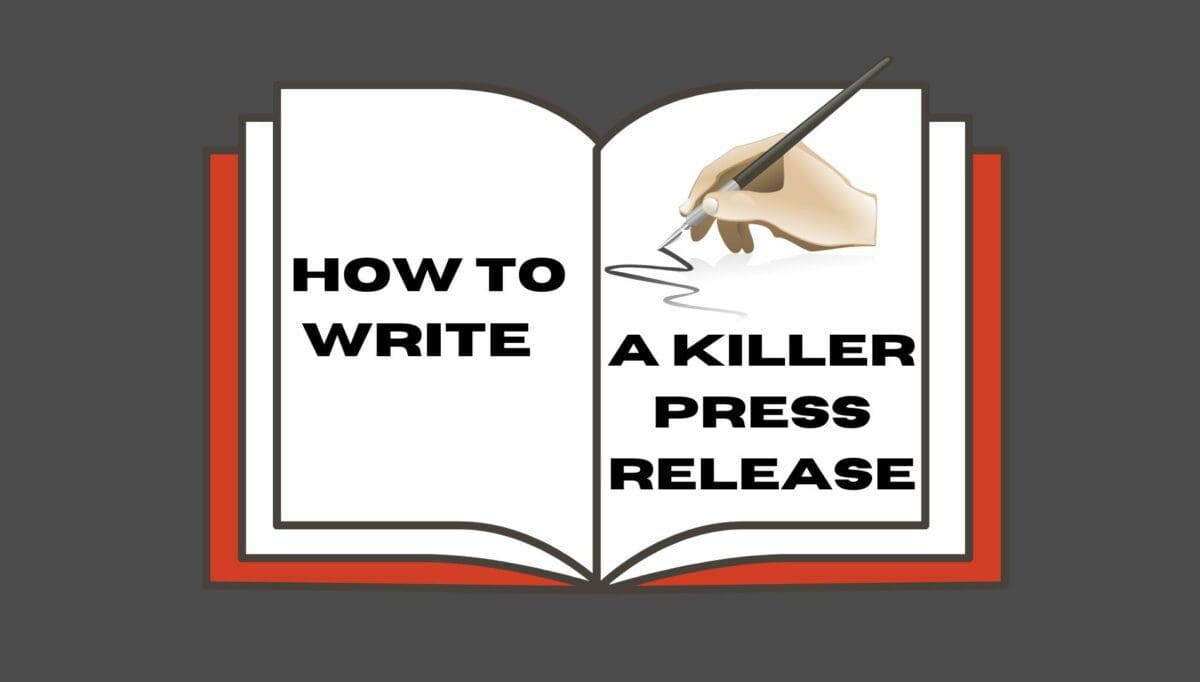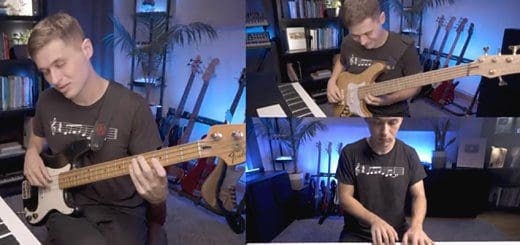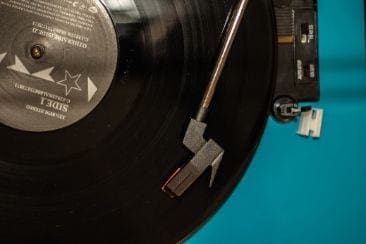There’s more to singing than just the chorus and verses. You may have to talk to the audience during a song intro. How do you introduce yourself as a singer and how do you perform when there are no vocal parts?
The first an audience sees of you is when you’re introducing yourself on stage as a singer. Learn the methods to convey personality and confidence when speaking and when performing in the instrumental sections and breakdowns. These are opportunities to shine.
In this article, you’ll find out the top techniques used to introduce a singer, read about song structure and discover the best breakdowns of all time.
Introducing yourself on stage as a singer

You’ve spent weeks, months, maybe even years practising your song or set. You’re note-perfect, know your lyrics inside and out, are on top of your marketing and social media campaign and have a killer outfit to boot. But wait, did you think about what you were going to say when you got out on stage?
Being a singer requires so much more than just the ability to, well, sing. It demands strong presentation skills, personality and the ability to get the audience on your side. It may seem like this career or vocation asks a lot. But fortunately many have gone before you and there are plenty of industry tips and secrets we can share to help when you’re introducing yourself on the stage as a singer and filling an instrumental section.
How to introduce yourself before singing a song
At the top of your number, you may want – or need – to give a little speech.
Before you start writing a lengthy oration thanking your mum, dad, pet dog and first music teacher, you’ll first need to consider the purpose of this speech. It has to be well thought out, sound natural and spontaneous, and be meticulously practised. Much like the song itself.
On a basic level, the speech should tell listeners who you are, and what the song is. Extra detail, like whether you wrote the song yourself and what it’s about, can also be useful and interesting. Imagine your speech as a mini public relations, or marketing opportunity to be seized.
Singing techniques and types of singing
Have a think about why you’re making this speech in the first place. What sort of song are you singing? Different types of songs and vocals require different approaches. You might be dramatic and solemn, or lively and bursting with energy. Watch your favourite singers. How do they introduce songs? What about those intros do you find appealing, or do you dislike?
Preparing an introduction speech before singing a song
The speech is all about introducing yourself to the audience. You need to do this using succinct language, meaning a few words. This is not the time for a waffle. It’s about telling the crowd who you are, and what the song is. And charming them in the process, so they’ll love you before you’ve even sung a note.
How to introduce a song on stage
Let’s look at some basic components needed when making a song introduction on stage.
- Clarity. What you’re saying must be clear, simple and easy to understand.
- Articulation. Pronounce your consonants for clarity, but without losing the charm of your own accent.
- Volume. There must be enough volume that everyone in the room can hear you. But don’t shout. It’s all about projection.
- Confidence. It must be delivered with assurance and self-confidence.
- Enthusiasm. Your audience won’t be enthusiastic if you’re not. Match your tone with the song’s vibe and you’ll be on track straight away.
- Warmth. You should appear likeable, both in what you say and how you say it. Unless you’re channelling the Gallagher brothers.
- Personality. Your individuality should shine through. This may occur naturally, but it’s worth being conscious of it too.
How to introduce a patriotic song
If you’re singing an anthem, or say, a patriotic song before a sports match or at an event, then your intro should be a little more serious than you may be at a gig. Be respectful and relate your speech to the team, or place, as appropriate. This will make the audience more receptive, as they are likely to be feeling very patriotic.
Often you will be introduced by somebody else at these kinds of events. As a rule, you shouldn’t speak through the intro, as these songs carry a lot of meaning and gravitas.
How to introduce yourself as a singer during a song into
You may not have the luxury of time before the music starts, to let the audience know who you are. In this case, or if you have a very long lead-in to fill, you may want to use the bars of the song intro to say your piece. This must be very carefully timed and practised – you don’t want to run out of notes and cut your speech off early.
This a unique introduction for myself
A unique introduction will stick in people’s minds. It can be funny, serious, or somewhere in between, but consider what’s different about you and use it to your advantage.
How do you introduce yourself in a singing audition?
Especially if the audition is being filmed, you may have been briefed as to what you should say. Stand out from the crowd at an audition by subtly using an emphasis on particular consonants or using a soft tone. Above all though, you should be confident and clear, stating your name and song.
How to introduce a singer on stage: sample speeches
There may be situations where you have to introduce someone else to the audience. Perhaps you’re a presenter, or you’ve been asked to welcome the next act, once yours is finished. If so, you might want to ask them what they’d like you to say and check the correct pronunciation of their name and song.
The guidelines for introducing someone else are very much the same as introducing yourself. The most notable difference is that, unless introducing an anthem or patriotic song, you’ll need to get the audience to applaud and – if appropriate – make lots of noise for their entrance. It’s also highly unlikely you’ll be doing any of this over the musical intro.
How to introduce someone to an audience
You should leave the stage as they arrive. And make sure their cue to enter is very clear. You don’t want to be standing there waiting, while they do the same backstage or in the wings. That would look awkward and unprofessional, confusing the audience.
The intro may be very brief – just letting everyone know the act’s name and song title. Or you might need to give a mini-bio and talk about any significant meaning the song might have. Ask the event organisers or producers exactly what they want, as well as the act.
Also, be sure to find out how long you need to speak. Some venues use a flash of a coloured light facing the stage (so you see, but the audience doesn’t) to let you know when your time is up.
Using a sample speech to introduce a person
If in doubt, use a sample speech as a guide. You can find examples of these online, or you can watch other presenters and singers doing their thing and develop your style from there.
Introduction speech before singing a song in Hindi, Italian, Latin or other languages
Many musical genres such as opera and Bollywood, have songs written in languages other than English. If the audience is unlikely to understand the lyrics, you may want to explain the story of the song briefly, and translate the title. If it’s not a language you usually speak either, do check you’re pronouncing it right.
Performance tips and singing techniques
As we’ve mentioned, the song isn’t just the bits where you’re singing. And in some, those instrumentals can last a long time. So what should you do during them?
There are many options that enable you to get creative. But you must do something. If you fidget, look uncomfortable or aimlessly staring at your feet it will make the audience uneasy and lose interest in your act. When you’re on stage you’re performing the whole time, from the moment you set foot in front of the crowd to the moment you’re out of sight.
To help you design your act, here are some options for things to do when there are no vocal parts in your number:
- Dance or move to the beat. This works best for pop and dance numbers and should be choreographed.
- Look at the audience wistfully, then look down, then look up again. For an example of this watch Adele.
- Talk to the audience, or if appropriate, incorporate a rap.
- Get backup dancers or backup singers with some ‘oohs’ and ‘aahs’.
- Use multimedia with screens behind you showing a cool video.
- Pick up and start playing an instrument, if you’re able.
Which you opt for will really depend on whether the song is a ballad, or up-tempo and what genre of music you’re singing. It also depends on what resources you have available and your budget – high-tech multimedia and backup dancers are much more expensive options, but lead to a more high-end effect.
What is an instrumental break?
An instrumental break is a period during the song where there’s no singing. The music instrumental is a good opportunity to express your personality rather than do nothing, which can then feel like the music instrumental section goes on forever.
Ways to use the music instrumental
Below are a few more pointers to help you fill those precious seconds during any music instrumental.
It’s very off-putting to watch a static performance by a singer, even more so during music instrumental when there’s no singing and as it can leave the singer very exposed. Those few seconds during music instrumental can come across longer due to the lack of performance.
As a singer, it’s likely you’ll hear how important it is to not only sing but to perform whilst you’re singing. There’s a big difference between a singer and a performer.
The music instrumental is an excellent opportunity to make use of this advice and give something visual. As music instrumental can often last for a few seconds, these are seconds that can be used to perform.
Examples of this can be simply moving around the stage, taking the mic off the stand or simply using your arms.
Remember that there are huge resources at your fingertips, study other performers’ live performances on YouTube or your favourite artist at a concert.
Start to pick up what works and what doesn’t within instrumental sections for various performances. This could be talking to the audience, giving expression in the face appropriate to the song. Then try and test them out yourself.
Music Instrumental
Getting the audience involved
The music instrumental can be awkward, yes, but making the most of that time can be invaluable. Audience participation is potentially a great way to fill those moments during the music instrumental.
Simply gesturing to the audience to clap or sway depending on the tempo of the song can help you fill the time of the instrumental section plus it also helps connect and engage with the audience.
The best breakdowns of all time
We’ll take a look at some of the best breakdowns of all time. Obviously which is the ‘best’ is always going to be subjective. But here are some tracks that appear time and again on lists for the numbers containing the top breakdowns:
- Insomnia by Faithless
- The Launch by DJ Jean
- Hey Boy Hey Girl by The Chemical Brothers
- 9 pm (Till I Come) by Fatboy Slim
- Levels by Avicii
- Encore Une Fois (Future Breeze Remix)by Sash
- Breathe by Prodigy
- Heaven by DJ Sammy
- Sandstorm by Darude
- Romance is Dead by Parkway Drive
- Domination by Pantera
But what is the breakdown in music?
This is where the track is stripped back. It might be to one instrument, just percussion, no percussion or an instrumental section. It helps the journey of the track, allows for a sense of momentum to be built.
What is the break-in hip hop?
In modern hip hop specifically, the break can be any section of the track (but usually four bars) that can be sampled and repeated.
Singers can use music instrumentals or breaks to make their performance more dynamic. For example, ad-libbing parts of the song can help to fill those gaps. Ad-libbing helps the performance become more dynamic as it adds sections to the song that the audience doesn’t expect to hear.
Many well-known singers, especially hip hop artists, ad-lib in every one of their songs, most commonly used words and phrases such as yeah, okay or come on!
What makes up a pop song and the parts of a rap song?
All songs follow some kind of structure. There are various ingredients that can be used in a song. These are:
- Intro
- Outro
- Breakdown/break
- Chorus
- Bridge or middle 8
- Verse
- Tag
- Drop
Song arrangement structure: Verse – chorus – bridge song examples
Many pop songs follow this particular and most common structure. It can be heard in artists ranging from Taylor Swift and Miley Cyrus to Coldplay and The Police.
Using a song structure chart or song arrangement template
If you’re writing your own music, you need to understand its anatomy. Use a guide and chart or template to help you format your pieces easily. You can find out much more about the techniques of song structure, song structure for bars of music and how to better understand the anatomy of music, by reading our article dedicated to this topic.
Now it’s clear what an opportunity these extra parts of the performance offer, it’s time to get working on your act. How will you go about introducing yourself as a singer? How can you maximise your potential for performing in the instrumental sections and breakdowns?
If you’re unsure, think about working with a voice or performance coach, or getting some artist development sessions with a studio (this is especially useful for dance music vocalists, who may want to use backup singers and backup dancers).
Related questions
- How do you sing on stage for the first time?
There are ways you can hide your nerves at your first performance and ensure you’re as prepared as possible. These techniques will help you feel confident and able to enjoy yourself. You can read our article with tips for performing on the stage for the first time, to get you ready for your debut.
- What should you not do before singing?
Make sure you’re ready for your slot – don’t disappear to the loo. Don’t gulp cold water, lukewarm is better and take care of eating. Try to have a light meal or snack for a while before going on stage. Don’t tap the mic or start testing your equipment. This should be done during a pre-show soundcheck.
- What is the breakdown in EDM?
Electronic Dance Music, or EDM, has a strong beat creating intensity and energy ideal for – dancing. The breakdown is a kind of rest period in which it’s stripped back to the melody and basic chords. It’ll usually then build back up to a full-on bass-filled beat.
Have you had experience introducing yourself on stage as a singer? What do you do during a breakdown or instrumental section? Tell us in the comments below.










